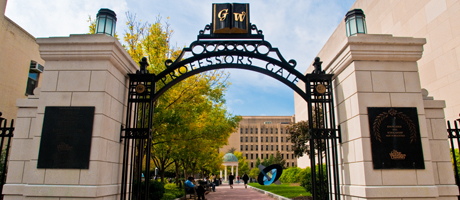By Mary Dempsey and Jamie L. Freedman
GW’s academic community added 61 new full-time faculty members this fall across disciplines.
“We’ve made some stellar hires this year,” says Donald R. Lehman, executive vice president for academic affairs and the George Gamow Professor of Theoretical Physics.
“We are particularly pleased that we’ve attracted a number of great new faculty members to our signature program groups, such as history, political science and high-performance computing. It speaks extremely well for GW that we are competing with the very best universities for the very best faculty.”
The new group includes nationally renowned historian Jenna Weissman Joselit, who joined GW this fall from Princeton University as the Charles E. Smith Chair in Judaic Studies.
“These outstanding scholars will help move us closer to realizing our goals of providing high quality educational offerings across the disciplines and raising GW into the top tier of research institutions,” says Dr. Lehman.
One high-profile newcomer is Charles Glaser, a top scholar in international relations theory and security policy with expertise in nuclear forces and strategy. Dr. Glaser left the University of Chicago to join GW as a professor of political science and international affairs in the Elliott School of International Affairs.
“GW has a very strong international relations faculty, and Washington is a great place to do security policy,” Dr. Glaser says.
Dr. Glaser is founding director of the Elliott School’s new Institute for Security and Conflict Studies. The institute’s research focus includes nuclear weapons and proliferation as well as energy and security.
Another new face at the Elliott School, James Foster, is a development specialist known globally for devising tools to measure poverty. He held positions at Purdue University and Vanderbilt University before joining GW.
Dr. Foster says the ability to measure the impact of anti-poverty policies has become critical in determining the effectiveness of government strategies and development aid. He has a special interest in Latin America and collaborates with the United Nation’s Development Programme in the region.
“GW is a school with a real future,” Dr. Foster said in explaining his decision to join the University. “And it has such a location advantage, especially in my field. You’ve got the World Bank, the International Monetary Fund, the Inter-American Development Bank as well as colleagues here at the Elliott School who are some of the top experts in their fields.”
The Department of History, meanwhile, added six new faculty members with expertise in areas as diverse as African American women’s history and Korean history. Among the new appointments is one of academia’s top labor historians: Eric Arnesen.
Dr. Arnesen has a special interest in African American labor history and is working on a biography of A. Randolph Phillip, who organized the Brotherhood of Sleeping Car Porters, the first African American union in the United States.
“Our strategy has been to hire the absolute best people we can,” says William Becker, chair of the Department of History. He pointed to Erin Chapman, currently at Princeton University on a Ford Foundation fellowship, and Jisoo Kim, who is completing a research fellowship at the Seoul National University. Both will join Dr. Becker’s department next year.
Dr. Chapman is doing “extraordinary” work in the area of race and culture and African American women’s history, he said. Dr. Kim is involved in innovative research on women’s history and the law in Korea. “She’s opening up a whole new field of scholarship,” Dr. Becker says.
Another new standout in the department is Katrin Schultheiss, whose focus combines French history, women’s history and medical history. GW’s proximity to the National Library of Medicine helped lure her to Washington from the University of Illinois.
“That library is the gold standard for medical libraries in this country. And there are all kinds of other terrific resources here for doing research,” says Schultheiss, who is currently writing a cultural biography of the Charcots, a prominent French family that included the world’s first neurologist, professional female artists and a polar explorer.
Schultheiss wants to carry on a tradition she started at the University of Illinois: a model world conference on women’s rights, built on a United Nations concept. She organized it for public schools in Chicago and hopes to replicate the effort in D.C., perhaps under the umbrella of the Women’s Leadership Program on the Mount Vernon Campus.
Two new faculty members have joined one of GW’s fastest-growing programs: high-performance computing.
Guru Venkataramani, an assistant professor in electrical and computer engineering, says the ability to combine undergraduate teaching and research was one of the reasons he joined GW. He teaches an undergraduate course in logic design and will offer a graduate course in computer architecture in the spring semester.
“I see great opportunity for exciting research in the computer architecture and high-performance computing group here,” says Dr. Venkataramani, who aspired to be a physician until he was bitten by the computer science bug. “I’d like to be a part of helping GW become one of the leading universities for computer engineering over the next five or 10 years.”
Man-Lap (Alex) Li says the size of classes at GW allows more personal interaction with his students in both teaching and research.
“GW is already a research university, and I’d like to add value to the research in this department,” says Dr. Li, who focuses on microprocessor performance and reliability. He predicted that computer engineering can help robotics, energy and sustainability to become areas of excellence for GW.
“Drs. Li and Venkataramani have conducted their doctoral research in two of the best groups in the country and have focused their work on the so-called multicore processor architectures,” says Tarek El-Ghazawi, founding director of GW’s High-Performance Computing Laboratory. “These are emerging computer chips that can have many processors per chip. Their work focuses on improving the programmability and the reliability of such chips and high-performance computers that are built with them. These are very complementary sets of expertise to our ongoing research program.”


